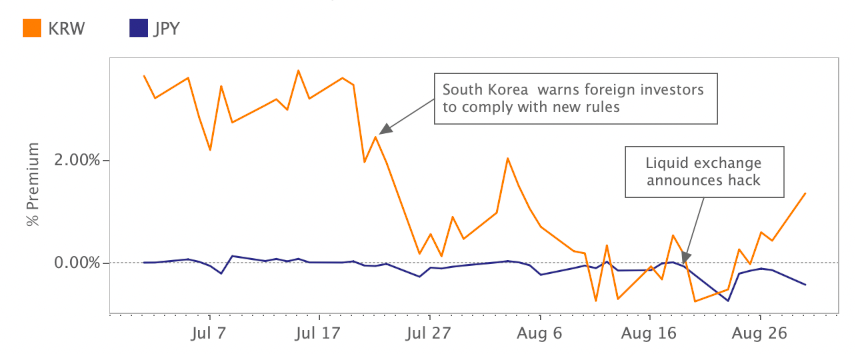A summarizing review of what has been happening at the crypto markets of the past week. A look at trending sectors, liquidity, volatility, spreads and more. The weekly report in cooperation with market data provider Kaiko.
The last 7 days in cryptocurrency markets:
- Price Movements: A discount has emerged on Korean and Japanese Bitcoin markets following an exchange hack and broader regulatory crackdown.
- Volume Dynamics: FTX's spot market share is growing rapidly relative to its biggest competitors.
- Order Book Liquidity: Ethereum's market depth recovered after falling to yearly lows during May's sell-off.
- Macro Trends: Bitcoin's correlation with Gold has been negative for the longest period of time since 2018.
Bitcoin now trades at a discount on Asian markets

Since mid-August, Bitcoin has traded at a discount relative to the U.S. Dollar on Japanese and Korean markets following an exchange hack and regulatory crackdown in the region. In Japan, a discount of -0.7% emerged shortly after Japanese-exchange Liquid announced a 97 million USD hack, one of the largest centralized exchange-related hacks to occur over the past year. The news caused traders to quickly cash out of the exchange by selling their BTC holdings, placing downward pressure on global BTC-JPY markets.
Japan’s closest neighbour, South Korea, has also undergone a sharp dip in BTC-KRW markets over the past month, with Bitcoin dropping to a low of -0.7% vs. the Dollar. The ‘Kimchi Premium’, a crypto phenomenon referring to a positive spread in the price of Bitcoin across USD and Korean markets, has declined since the end of July after topping extreme highs of +20% in April. The recent regulatory crackdown is a likely culprit for the sharp shift in market structure, which has dampened demand for Bitcoin on Korean exchanges. The latest round of regulations requires exchanges to register with the country’s financial watchdog or face closure. While the largest Korean crypto exchange Upbit announced it has complied with the new regulations, other exchanges such as Binance have since halted activity or payment operations using the Korean Won.
FTX gains market share
Over the past year, FTX has become one of the biggest success stories in the exchange space and today poses a legitimate competitive challenge to more globally established venues like Binance and Coinbase. FTX launched in 2019 and was originally known for their innovative derivatives contracts, highly leveraged products and rapid listings. More recently, FTX has became a force in the crypto mainstream and generates massive revenues across both spot and derivatives markets. Above, we compare FTX's market share of Bitcoin spot volume with Binance and Coinbase's Bitcoin spot markets.
FTX used to have relatively low spot volumes with a user base mostly trading derivatives. We can observe that since November 2020, FTX's BTC spot volume as a percentage of total volume has surged from 2.5% to 15.5%. This is quite a sharp shift in market structure which suggests that the exchange has recently managed to attract a wider range of traders. FTX Global currently does not service U.S. traders but the exchange's U.S. affiliate is aggressively ramping up marketing efforts, partnerships and regulatory relationships, which could pose a strong competitive threat to Coinbase. Binance still reigns supreme in global spot markets boasting 70% market share, but as we know by now in the rapidly shifting crypto industry, exchange dominance is tenuous.
Ethereum market depth recovers
In late May as crypto markets spiralled downwards, market depth - as measured by the quantity of bids and asks on ETH-USD order books - dropped to yearly lows across most major exchanges. Market makers were struck by unusually high volatility following a series of liquidation spirals that caused Ethereum to drop precipitously from all time highs. Volatility often causes market makers to pull limit orders so as to avoid being caught in an unfavourable price swing. Since May's volatility, market depth has since recovered and now sits near Jan-March levels. Bitfinex still possess the deepest ETH-USD books, second to Coinbase, but we can observe that Itbit is catching up over the past month.
Bitcoin-Gold correlation is consistently negative
Bitcoin’s correlation with Gold has been negative since March, hitting a low of -0.42 in early June. This has been the longest period of negative correlation between the two assets since 2018, which suggests a lasting reversal in their relationship. A strengthening U.S. Dollar in August (+0.8 m/m) put pressure on gold prices, which recently fell to a four-month low despite rising inflation. Gold is down 7% YTD while Bitcoin is up 62%. The crypto asset today is more aligned with the S&P 500 equities index, which is up 21% YTD and has continued to break record highs.







